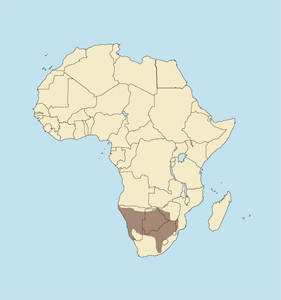 |
Parahyaena brunnea
Hiena parda (Sp), Braune Hyäne (G), Hyène brune<'em> (F), Strandjut, Strandwolf (Af).
DESCRIPTION Length, including tail, 50-64 inches (127-163 cm). Shoulder height 25-34 inches (64-86 cm). Weight 80-105 pounds (36-48 kg). Males are usually slightly larger than females.
Intermediate in size between the spotted and striped hyenas. The muzzle is comparatively short. The ears are long and extremely pointed. The coarse, very shaggy coat is dark brown in color except for a tawny-white mantle on the neck and shoulders. The head is gray. The lower legs and feet are gray with dark brown stripes. Tail is short and bushy. Genitalia are normal, unlike those of the spotted hyena.
BEHAVIOR Very shy, cautious and nocturnal, remaining hidden by day in holes or thick cover. It forages alone, but associates loosely in "clans" that have fixed territories. A clan usually includes a dominant male, several subordinate males, several adult females and their young. Breeding occurs mainly May-August, with usually three cubs (range is 2-5) born August-November. The young of two or more litters may be raised together in a communal den.
The brown hyena is mainly a scavenger, though it does take small mammals, birds, reptiles and insects, and eats fruit and crops. It is a poor hunter of larger prey, with most attempts ending in failure. In coastal regions it feeds on dead or stranded marine animals and fish. It hides surplus food for future use. Its cry is a loud, melancholy "wah-wah-wah." Senses of smell and hearing are very good, eyesight is good. A great wanderer, it travels long distances in search of food.
HABITAT Dry savannas, often rocky areas with desert or thick brush, sometimes seashores.
DISTRIBUTION Found only in southern Africa south of the Zambezi River, from southern Angola to mid-Mozambique. Rare within its range.
TAXONOMIC NOTES No subspecies are recognized.
STATUS Classified as endangered by the USF&WS (1970) and on Appendix II of CITIES (1975), but downlisted from threatened to lower risk (least concern) by IUCN (1996). Although biologists consider its reputation as a predator to be greatly exaggerated, it is killed on sight by many farmers who believe it is detrimental to livestock.
|





